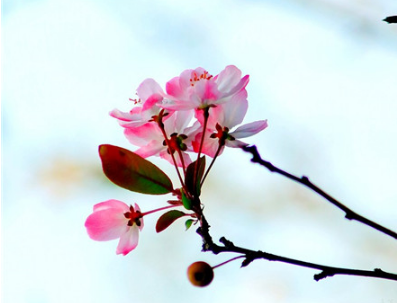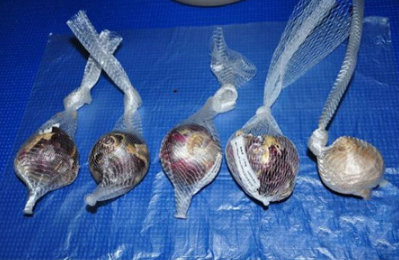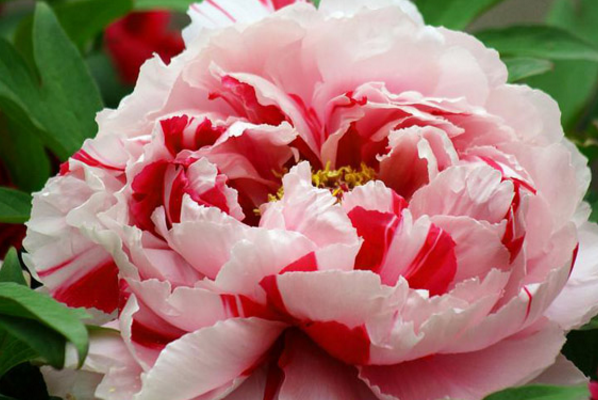When does the flower bloom and when does it bloom?
Yangxifu Begonia is a plant of the genus Malus of Rosaceae, which is endemic to China. Xifu Begonia grows best in the north and has great greening function.
Breeding methods and matters needing attention of Begonia in Xifu

1. Light and temperature
The environment in which begonia grows requires adequate light and proper temperature.
Placing Xifu crabapple in an environment with good ventilation and scattered light will help it absorb sunlight and promote its growth. The suitable temperature for the growth of Xifu crabapple is about 20 degrees, just keep it balanced.
Note:
Don't shine directly on the bright light, so as not to damage the leaves. Winter should be placed in the sunny shelter for maintenance, summer dry and hot season should pay attention to ventilation shade, can not always shine on the sun.
3. Watering and fertilization
The watering method of Xifu begonia is to keep the basin soil moist for the best condition. High air humidity is conducive to growth, so it is necessary to properly spray water on the leaf surface and the surrounding ground to moisturize.
Xifu Begonia is fertilized during the growth period, and thin cake fertilizer and water fertilizer is applied about every 10 days.
Note:
Xifu crabapple watering can see that the basin soil is moist, do not accumulate water, otherwise the roots will rot; winter watering should be controlled to reduce the amount of water.
When fertilizing, we should pay attention to the fertilizer liquid should not be sprayed on the leaves, lest damage also piece, must pay attention to each flowering season and winter, summer two seasons do not apply fertilizer.
Because the plants of western crabapple are tall and easy to tilt, it is necessary to support branches with supports such as fine bamboo to prevent lodging and hinder growth.
In every spring, to turn the basin, change the soil, prune, as long as the weak branches, overlapping branches, residual roots can be cut off.
Note:
When binding Xifu begonia, pay attention to the use of twigs, do not use thick branches to affect the development and growth of branches and buds. When turning the basin, pay attention to the addition of new soil, increase nutrients, do not hurt the roots.
When will it blossom
1. The flowering period of Malus sinensis
The flowering period of West House Begonia is usually in spring. Flowering usually begins in February and can last until May. However, specifically, according to the influence of climate, environment and other factors, the flowering time is slightly different. Generally, the flowering period of Begonia in the north is later than that in the south. The flowering of begonia usually lasts about a week.
2. Regulation of florescence of Malus sinensis.
Today, with the development of science and technology, the florescence of Begonia can also be controlled manually, and its florescence can be delayed or advanced. The main purpose of regulating the flowering period of western begonia is to control the maintenance temperature of western begonia.
Put the west crabapple in the low temperature environment to make it dormant, about a month before the scheduled flowering, gradually begin to raise the temperature, and spray water every day, can make the west crabapple grow buds, at this time keep the temperature at 10 ℃, enhance the light, the buds can develop color, and then can bloom normally.
Note that if the bud appears late at this time, it can be warmed or sprayed with potassium dihydrogen phosphate to promote its flowering.
Culture methods and matters needing attention of Begonia in Xifu
Culture methods and matters needing attention of Begonia in Xifu
The culture method of Xifu crabapple is very simple, as long as it grows in accordance with its environment.
Light and temperature
The environment in which begonia grows requires adequate light and proper temperature.
Placing Xifu crabapple in an environment with good ventilation and scattered light will help it absorb sunlight and promote its growth.
The suitable temperature for the growth of Xifu crabapple is about 20 degrees, just keep it balanced.
Note:
Don't shine directly on the bright light, so as not to damage the leaves.
Winter should be placed in the sunny shelter for maintenance, summer dry and hot season should pay attention to ventilation shade, can not always shine on the sun.
Watering and fertilization
The watering method of Xifu begonia is to keep the basin soil moist for the best condition. High air humidity is conducive to growth, so it is necessary to properly spray water on the leaf surface and the surrounding ground to moisturize.
Xifu Begonia is fertilized during the growth period, and thin cake fertilizer and water fertilizer is applied about every 10 days.
Note:
Xifu crabapple watering can see that the basin soil is moist, do not accumulate water, otherwise the roots will rot; winter watering should be controlled to reduce the amount of water.
When fertilizing, we should pay attention to the fertilizer liquid should not be sprayed on the leaves, lest damage also piece, must pay attention to each flowering season and winter, summer two seasons do not apply fertilizer.
Tie up and turn the basin
Because the plants of western crabapple are tall and easy to tilt, it is necessary to support branches with supports such as fine bamboo to prevent lodging and hinder growth.
In every spring, to turn the basin, change the soil, prune, as long as the weak branches, overlapping branches, residual roots can be cut off.
Note:
When binding Xifu begonia, pay attention to the use of twigs, do not use thick branches to affect the development and growth of branches and buds.
When turning the basin, pay attention to the addition of new soil, increase nutrients, do not hurt the roots.
Culture methods of Begonia in Xifu breeding methods of Begonia
Western crabapple, also known as son's mother begonia, is one of the traditional famous flowers in China. Today, we will share with you the culture methods and breeding methods of Western crabapple.
Culture methods of Begonia in Xifu:
1. Planting. Western crabapple is generally planted in many rows, and it is appropriate to sprout in early spring or after defoliation in early winter. Keeping the intact root system of the seedling when coming out of the nursery is the key to survival. Generally speaking, big seedlings should bring soil rope, and small seedlings should stay in the lodging soil according to the situation. After the seedlings are planted, the tending and management should be strengthened and the seedlings should be kept loose and fertile.
2. Trim. A pruning was carried out from the defoliation to the sprouting in early spring to cut off the weak branches, disease and insect branches in order to keep the crown open, ventilated and transparent. In order to promote the vigorous flowering of the plant, the overgrown branches must be cut short to reduce the nutrient consumption of germination. Fruiting branches and rubbing branches need not be pruned. During the growth period, if the heart can be removed in time and the vegetative growth is restricted in the early stage, the effect will be more significant.
3. Watering and fertilizing. In order to make Xifu begonia beautiful in flowers and colors, it should be planted on well-drained, fertile and moist land. The planting time should be carried out early before spring bud germination, and rotten organic fertilizer should be applied before planting. Every autumn, after falling leaves, dig a circular ditch around its rhizosphere, apply mature organic fertilizer, cover the soil and pour through water, it can make the branches flourish and the flowers are beautiful in many colors. Watering at the seedling stage should be diligent to keep the soil moist, but not stagnant water, timely drainage should be needed in the rainy season, and middle roots should be loosened once every 2-3 weeks to facilitate ventilation.
The method of propagation of Begonia sinensis
There are generally three propagation methods of begonia in Xifu: grafting, ramet and root burying. Western begonia cuttings are difficult to survive.
1. Grafting method: the buds and branches of Xifu begonia are grafted, and the rootstocks are mostly used as seedlings of the same genus. The bud grafting of begonia should be carried out in August and the branch grafting should be carried out in spring.
2. The ramet method: the ramet of Malus sinensis is suitable in early spring in March, before sprouting. In some years, small seedlings will sprout around the western crabapple, and the seedlings will be cut off from the mother plant with roots. After watering through the water, the seedlings of Malus sinensis were properly shaded to keep the soil moist, and entered normal management after 15 days.
3. The method of burying roots: from February to March in early spring, the root cut of adult begonia grew about 15 centimeters, buried flat in the soil, covered with 7-8 centimeters of soil, watered thoroughly, and then often kept the soil moist, and then cut off the mother in the early spring of the following year for planting.
More information
- Prev

Where is the best hydroponic method for hyacinth placed at home?
Hyacinth is a very popular flower, which can be seen in many people's homes and offices, so do you know that hyacinths should not be put in those places at home? Do you know how to cultivate quick and convenient hyacinths? I don't know. Let's go and have a look.
- Next

Peony culture is not suitable for potted peonies how to water peonies
Peony flowers are elegant and magnificent. I believe everyone likes them very much. Like to raise one or two plants, in the breeding time careful care, I believe that in their own careful care, peonies will be able to raise bright colors. Peony culture is not suitable for peony flowering. Peony flowers are in full bloom.
Related
- Fuxing push coffee new agricultural production and marketing class: lack of small-scale processing plants
- Jujube rice field leisure farm deep ploughing Yilan for five years to create a space for organic food and play
- Nongyu Farm-A trial of organic papaya for brave women with advanced technology
- Four points for attention in the prevention and control of diseases and insect pests of edible fungi
- How to add nutrient solution to Edible Fungi
- Is there any good way to control edible fungus mites?
- Open Inoculation Technology of Edible Fungi
- Is there any clever way to use fertilizer for edible fungus in winter?
- What agents are used to kill the pathogens of edible fungi in the mushroom shed?
- Rapid drying of Edible Fungi

